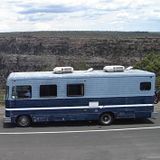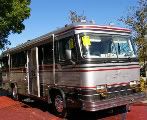Go to...  | Start A New Topic  | Search  | Notify  | Tools  | Reply To This Topic  |  |
 3/23 3/23 |
Up for discussion, why use 2or3 way refrigerators? I found it interesting that Chris Craft used 110VAC fridges for the boats and many houseboats (generally ones built like camping trailers) used multi-powered. I needed to replace my original (110VAC)and found the only restriction was the need for an undercounter type. This raised the price quite a bit but not to the level of RV types. Interesting points to consider 1. Price of 110VAC units is generally less than 1/3 that of the multi-power units. 2. Cooling capacity is greater for the 110 units. 3. 110 units do not consume much power if treated like multi-power units. My 6 cu.ft. unit is about 90 watts when running with the door open so the light is on. A 12 cu. ft.unit should not be double and a small inverter can power the fridge. If you use or have a reasonably sized inverter it should handle the fridge and possibly one duplex outlet. Even if you are boondocking a pair of house batteries will handle the fridge until you decide to move on or crank up the A/C. In the Spring and Fall I never use the genny unless I am told by my bride we need to make coffee in the AM without waiting for the BBQ grill to get cranking. | ||
|
| First Month Member |
When I had a perm fiver in a park, I replaced the Dometic fridge with a similar size one from Costco. Don't remember the name, but it drew under 100 watts and ran about a third of the time. Ran half the time when temps were above 100. (Lower Colorado River) Liked it so much I put another one in a closet. For one fridge, that works out to 33 watts/hour, or 800 watt/hours per day. When you factor in efficiency losses involved with inverters, you are probably around 1000 watt hours per day. That comes down to around 75 to 100 amp hours per day. In addition, you have to decide whether to chance it with an MSW inverter or a true/pure sine wave inverter. There is no way to predict in advance how well or how long a particular device will work with an MSW inverter. To keep the batteries up, you would need several hundred watts of solar panels, since they only work around 5 to 6 hours a day equivalent. If you recharge with a generator, some of the math will involve the size of the battery bank, its state of charge when charging is initiated, since lower SOC batteries take more amps. Another factor is the size and sophistication of the charger, as well as the temperature of the batteries. My pair of golf cart Trojans when discharged to 50% SOC start out taking 30 amps but the charge rate quickly drops down to about half that. At 15 amps, it would take five to seven hours (or more) to put 75 to 100 amp hours back in. Plus charging losses. And that is not counting the lowering of the charge rate as SOC rises. Somebody check my math, as I'm tired. In a perfect world, I would have a roof full of solar panels and a basement full of batteries and a couple of those compressor fridges inside. . 84 30T PeeThirty-Something, 502 powered | |||
|
Glassnose Aficionado |
I guess it depends on your use and set-up. I can see where if you had a really good set of batteries and a good inverter you could get away with 110 only, but for my purposes I spent the extra bucks for a propane fridge. When we go to Dega we're on the road for 10 hours with a weeks worth of frozen and fridged food in there, so I want the fridge running. Once at the track it's 4 days of not being plugged in. The genny runs when we need it but often no more than a little while in the morning to make coffee and breakfast. Now that I've brought up another topic, I'll listen to what others say about travelling with the LP on and the fridge running on it. I've been told by some to NEVER do it, but when I rented Cruise America coaches they said to run it on LP when on the road. The tech that installed the fridge said there is no way for it to catch fire on the road, and from what I understand the other danger is an accident where the line is broken, but I've been told my in-tank valve will shut if there is a sudden escape of gas. 79 Barth Classic | |||
|
 |
I run our Fridge on propane when we are driving so I don't have to run the generator all the time. It's a 2 way and we have been doing this for 7 years without any problem. Ed. | |||
|
My generator is propane powered. I like the roof A/C on when I'm driving and the frig is also running on the propane. I'm aware you should turn off the propane tank prior to entering a service station, but I'll admit I have forgotten a few times. Former owner of "THE TOY" 1988 Barth Regal SE 33' Tag 1992 Barth Breakaway 32' 2005 Coachmen Mirada 32' DS | ||||
|
| First Month Member |
As far as driving goes, our fridge is 3 way, so when driving, it is on battery. If the sun shines, the solar panels carry the load. If not, the alternator does it. . 84 30T PeeThirty-Something, 502 powered | |||
|
 |
Be sure to check for recall notices on your model refrigerator. The concern is that a faulty weld of the the ammonia system will allow the ammonia gas to reach the propane flame. Whether that is somehow mitigated by the airflow of travel, I wouldn't guess. Matt 1987 Barth 27' P32 Chassis Former State Police Command Post Chevrolet 454 Weiand Manifold, Crane Cam, Gibson Exhaust | |||
|
Captain Doom |
The prior owner installed an inverter to run the reefer underway. A relay kicks the unit over from shore power to the inverter. Rusty '94 28' Breakaway: MilSpec AMG 6.5L TD 230HP Nelson and Chester, not-spoiled Golden Retrievers Sometimes I think we're alone in the universe, and sometimes I think we're not. In either case the idea is quite staggering. - Arthur C. Clarke It was a woman who drove me to drink, and I've been searching thirty years to find her and thank her - W. C. Fields | |||
|
 3/23 3/23 |
That is how mine works. I installed a Freedom 1000 inverter/charger and have it running the fridge and one outlet. The house banks and starting banks are make before break selector switched. As soon as the shore power is switched off the inverter takes over (microwave clock stays set). When the power comes back on the inverter continues for several minutes before transferring power back to line and switching over to charge mode. | |||
|
 1/11 1/11 |
I HAVE RUN PROPANE ON OUR FRIDG IN ANY UNIT WE OWNED SINCE 1964. GUESS YOU COULD HAVE SOME TROUBLE IN A BOAT THEY ROCK SO HARD THAT THE FLAME COULD MISS THE PIPE IN THE FRIG.THE FLAME IS AS SMALL AS A MATCH OR A PILOT LIGHT ON A STOVE.USUALLY THE RV IS ON FLAT GROUND AND WOULD NOT MISS THE TUBE.NOW ON THE NEW ONES THINGS COULD HAVE CHANGED I HOPE NOT BECAUSE THE BARTH HAS 2007 IN IT LENNY lenny and judy 32', Regency, Cummins 8.3L, Spartan Chassis, 1992 Tag# 9112 0158 32RS 1B | |||
|
 3/23 3/23 |
When we took our TT out I always lit the reefer prior to leaving the driveway. My friends that claimed to have some knowledge about this allowed the flame was well protected from drafts that might blow it out and the jiggling on the road kept the coolant from pooling. Seemed to work well for our experiences. Food and beverages were ready when we unhitched. That is the test isn't it? | |||
|
| Powered by Social Strata |
| Please Wait. Your request is being processed... |
|
This website is dedicated to the Barth Custom Coach, their owners and those who admire this American made, quality crafted, motor coach.
We are committed to the history, preservation and restoration of the Barth Custom Coach.
We are committed to the history, preservation and restoration of the Barth Custom Coach.